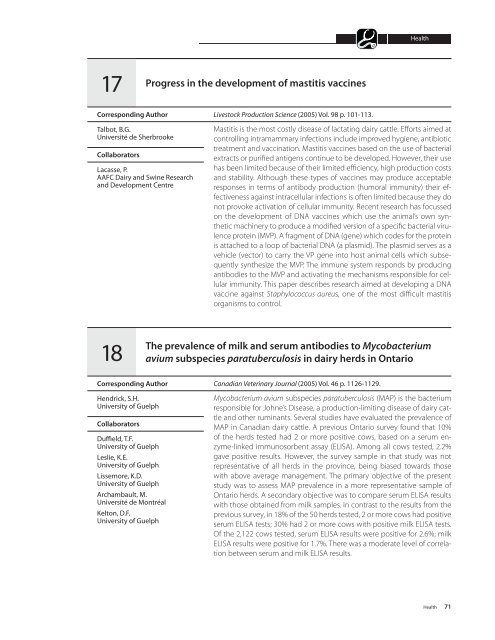A52-75-2007E.pdf - AgroMedia International Inc
A52-75-2007E.pdf - AgroMedia International Inc
A52-75-2007E.pdf - AgroMedia International Inc
You also want an ePaper? Increase the reach of your titles
YUMPU automatically turns print PDFs into web optimized ePapers that Google loves.
Health17Progress in the development of mastitis vaccinesCorresponding AuthorTalbot, B.G.Université de SherbrookeCollaboratorsLacasse, P.AAFC Dairy and Swine Researchand Development CentreLivestock Production Science (2005) Vol. 98 p. 101-113.Mastitis is the most costly disease of lactating dairy cattle. Efforts aimed atcontrolling intramammary infections include improved hygiene, antibiotictreatment and vaccination. Mastitis vaccines based on the use of bacterialextracts or purified antigens continue to be developed. However, their usehas been limited because of their limited efficiency, high production costsand stability. Although these types of vaccines may produce acceptableresponses in terms of antibody production (humoral immunity) their effectivenessagainst intracellular infections is often limited because they donot provoke activation of cellular immunity. Recent research has focussedon the development of DNA vaccines which use the animal’s own syntheticmachinery to produce a modified version of a specific bacterial virulenceprotein (MVP). A fragment of DNA (gene) which codes for the proteinis attached to a loop of bacterial DNA (a plasmid). The plasmid serves as avehicle (vector) to carry the VP gene into host animal cells which subsequentlysynthesize the MVP. The immune system responds by producingantibodies to the MVP and activating the mechanisms responsible for cellularimmunity. This paper describes research aimed at developing a DNAvaccine against Staphylococcus aureus, one of the most difficult mastitisorganisms to control.18The prevalence of milk and serum antibodies to Mycobacteriumavium subspecies paratuberculosis in dairy herds in OntarioCorresponding AuthorHendrick, S.H.University of GuelphCollaboratorsDuffield, T.F.University of GuelphLeslie, K.E.University of GuelphLissemore, K.D.University of GuelphArchambault, M.Université de MontréalKelton, D.F.University of GuelphCanadian Veterinary Journal (2005) Vol. 46 p. 1126-1129.Mycobacterium avium subspecies paratuberculosis (MAP) is the bacteriumresponsible for Johne’s Disease, a production-limiting disease of dairy cattleand other ruminants. Several studies have evaluated the prevalence ofMAP in Canadian dairy cattle. A previous Ontario survey found that 10%of the herds tested had 2 or more positive cows, based on a serum enzyme-linkedimmunosorbent assay (ELISA). Among all cows tested, 2.2%gave positive results. However, the survey sample in that study was notrepresentative of all herds in the province, being biased towards thosewith above average management. The primary objective of the presentstudy was to assess MAP prevalence in a more representative sample ofOntario herds. A secondary objective was to compare serum ELISA resultswith those obtained from milk samples. In contrast to the results from theprevious survey, in 18% of the 50 herds tested, 2 or more cows had positiveserum ELISA tests; 30% had 2 or more cows with positive milk ELISA tests.Of the 2,122 cows tested, serum ELISA results were positive for 2.6%; milkELISA results were positive for 1.7%. There was a moderate level of correlationbetween serum and milk ELISA results.Health 71





